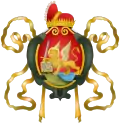Economic history of Venice
Venice, which is situated at the far end of the Adriatic Sea, was once the richest and most powerful centre of Europe for hundreds of years. The reason being that it gained large scale profit of the adjacent middle European markets. Venice was the major centre of trade with the Arabs and indirectly the Indians in the Middle Ages. It also served as origin of the economic development and integration for the rest of Europe during the Middle Ages.
The Venetian might reached its peaked during the 15th century when they monopolized the spice trade from India through the Arabs using exclusive trade agreements. This prompted the Spanish and the Portuguese to embark on the search for the new route to India, leading to the discovery of Americas and the start of the Modern Age.
Nevertheless, only the nobility or patriciate had the right to exercise the wealth-bringing long-distance trade. It was the same patriciate that erected a monopoly of political leadership. It left production and small business to the strata of its society that were not capable of becoming a member of the council - which was the visible sign of nobility. On the other hand, they provided protection against competitors, against violation of secrecy - and exercised strict control.
Ab initio, Venice had to face fierce competition and rivalry, especially coming from Genoa. War, whether declared or not, was the normal status that for four times culminated in year-long open wars, conducted with all means. Finally, the tiny - as far as its expanse was concerned - super power had to draw back, because the world powers of those days, Spain and the Ottoman Empire, had a world of natural and human resources, and Amsterdam, London and Lisbon had the political and economic means that Venice could not afford in that ever growing range.
In the 17th and 18th century, the regional power that had almost lost its entire colonial empire, was more and more specialized in the production of luxury articles and in agricultural products of the Terraferma.
Introduction
Taking and keeping control of long distance trade from Venice necessitated new means and measures of checking and controlling. The "commercial revolution" with its new cultural, organisational forms, not to forget with its new ways of living, lead to a never before seen predominance of economy, especially as the economically leading clans were at the same time incorporated in the vehicles of political power. Economic success attracted - as ever - thousands of people, amongst them many artisans with capabilities of utmost importance. With refining and melioration, new products could develop.
Venice's historical roots rest as far back as the Etruscan Culture. The settlements from which later on Venice grew up, could revive the late Roman trade with Northern Italy. At the same time Venice succeeded in extending its privileges in the Byzantine Empire. Byzantium as well as the Holy Roman empire were always prepared to concede privileges to the Venetian traders, when they were in heavy political constraints. These far going privileges - as quarrelled as they were - formed the judicial foundation for the preponderance of the Adriatic town in commercial matters. At the same time it reached its aims to overthrow the dalmatian and Italian rivals and to secure the routes of trans people.
Crusades and the conquest of the Byzantine Capital opened the direct ways to the East and far into Asia. But these voyages, similar to the costly convoys to Flanders, Tunisia, Syria and Constantinople, required huge amounts of capital, which normally means credit. This fact is closely combined with the early reduction of barter and a strong position of money-mediated trade. A long learning-process that lead to a rudimentary economic policy started, including patent protection, promotion of trade, but strategic help for the flux and leave of capital and metals. The crusades brought intensification of trade, of which Venice took profit so that it soon ranked first among the trading nations. Already a century before the sack of Constantinople (1204) many traders' colonies flourished. This provided (especially when keeping in mind the Venetian conquest of Crete and other important points) the backbone of free trade and of the convoys of large ships sent to the markets around the Mediterranean sea. In addition it offered many opportunities to regulate the local balances of power and secured partly the means of living - especially wheat - for the mother town.
The city could finance its everyday duties by revenues of the tariffs, but in difficult times it rigidly made recourse to the estate and capital of the thousand rich families. Money in its core in those days mostly consisted of gold or silver. As a consequence the economy depended heavily on the timely afflux and efflux of these metals. So Venice had to develop a highly flexible system of currencies and change rates between coins consisting of silver and gold, if it wanted to preserve and enhance its role as platform and turntable of international trading. In addition the change rates between the currencies circulating within Venice and outside had to be adjusted adequately. On the other hand, the nobility had hardly any scruples to force its colonies to accept change rates, which were only useful for the fisk.
In addition Italian traders were used to means of payment, which could help avoiding transportation of gold and silver which were expensive and dangerous. Crediting became a way to bridge the ubiquitous lack of noble metals, and at the same time, to accelerate goods turnover, were it with the help of a simple bank transfer, were it with the aid of a bill of exchange. Also available and helpful were to float loans, used as a kind of traders' money, circulating from hand to hand. Cambists played an important role just as well as the later state-controlled banks whose predecessors in Venice was the "wheat chamber" or Camera frumenti.
Despite the predominance of intermediary trade, ship building was an industry of utmost importance right from the beginning - and it was by far the most important employer. Quite important in the later Middle Ages were the production of drapery, of silk and glass. Still the salt monopoly was of utmost importance,[1] even more so the trade of wheat and millet. This trade did not contribute less to the wealth of the patriciate than the abundant rest of the trade.[2]
In early Modern Times the power of Venice reached its climax, but the tiny super power was unable to confront the enormous powers of the Ottomans and of Spain with their gigantic resources. By and by Venice lost its colonies and its monopoly for the trade in the Adriatic Sea. In addition capital of the Netherlands and of England overran the Venetian competitors, as they did not accept any Venetian trade monopolies and trade moved into the North Atlantic. In addition market access became ever more difficult because protectionism became rampant in most Mediterranean and European states.
Close to the end, the Venetian state became a conservative agrarian system, which, despite increasing tourism, met incomprehension. There was no broad decadence but a slow recidivism behind the expanding trade powers of the 18th century.
Until the 9th century
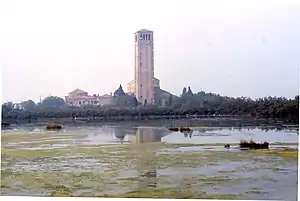
In antiquity the sea level was a few metres lower than today. Greek and Etrurian traces reveal much earlier settlements than expected. Chioggia (Clodia) was a Roman military colony and in the Fontego dei Turchi above the Canal Grande a coin from the days of emperor Trajan was found.
At the latest during the 6th century fishery, but overall sea salt and grain played the major roles.[3] At about 750 King Aistulf of the Longobards prohibited trade with the Byzantine subjects - that means obviously with the people of the lagoon as well.[4]
Around 780 traders at Pavia offered goods such as Tyrian purple from the orient.[5] Before 785 already, Venetian traders resided in Ravenna and in the so-called Pentapolis, men that had been "expelled" by the Franks in 787/791.[6] About thirty years earlier they did appear in the slave trade with the saracenes.[7]
Trading mostly meant drapery. Obviously coins and coinage were common - e.g. coins of emperor Louis the Pious were in use, but stamped with „Venecia“ on the reverse[8] -, but Venetians preferred the coins of Verona, although a Venetian zecca (Arabian word for coin) is verifiable for the ninth century already.
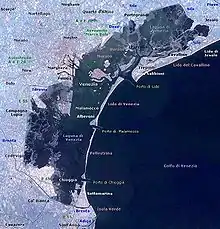
The early emporium of Torcello was soon replaced by Malamocco, later by Rialto. The nuclei around Olivolo, San Marco and Rialto made up three foci, one concentrated on ship building arsenal, one as political centre, one as centre of trade and exchange.
The early phase of „feudalization“ together with the acquisition of wide real estates, brought huge amounts of capital to certain families. The last will of the doge Giustiniano Participazio from 829 demonstrates, to which amount these families did invest their revenues into buildings, goods and adornments, but the more it is astonishing that they invested even more in credits and trading companies. The leading stratum was obviously involved in trading very heavily, much more than the nobility of the neighbouring mainland.
Between Byzantium and the Holy Roman Empire: 9th century to 1171/1204
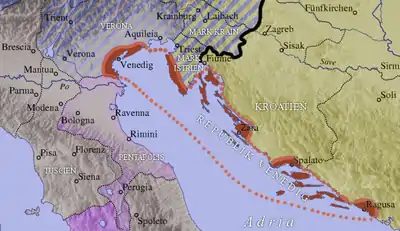
With the destruction of Comacchio (883) that controlled the mouth of the Po River, Venetians liberated the trade till Pavia and Piacenza – the more as a treaty with Charles "the Fat" had opened his Realm. Much more difficult was the relation to Istria and even more Dalmatia, where the Narentani, pirates of the Dalmatian coast resisted until 1000, when doge Pietro II Orseolo conquered the northern and central part of the region.
Privileges in the Holy Empire worked well together in combination with supremacy in the Adriatic Sea and a chart of the Byzantine Emperor of 992. In compensation for military aid against the Arabs of southern Italy emperor Basil II had reduced the tax for the ships by half. In addition Venetians started trade with Tunisia and Alexandria in Egypt where they delivered wood, weapons, metal and slaves, even though the trade with Islam was sometimes banned.[9] Emperor Leo V (813–820) had already forbidden this trade,[10] but during relatively peaceful times this ban was obviously loosened.
The breakthrough came in 1082 with the privilege of emperor Alexios I Komnenos, which guaranteed free trade and opened large parts of his Realm for the first time. Colonies for the merchants, Fondachi and wharves completed and enhanced the by far largest colony in Constantinople.
In the Holy Land, which was conquered by the Crusaders at about 1098, Venice gained the right of free trade, because it had helped Gottfried von Bouillon in 1100 and he subsequently conquered Tyros, the trade central in Syria. The colonies enjoyed autarchy and autarky. From Syria to Little Armenia they conducted their trade deep into Asia, with future colonies being eyed in Alexandria and the Maghrib.
The counterpart of the privilege of 1258 became the one of 1084 that emperor Henry IV ceded for his whole realm. Deeply mired in the Investiture Controversy he allowed Venetians to trade in his whole realm, but his subjects were not allowed to extend their trading activities over Venice. Together with the monopoly in the Adriatic Sea and the staple, and the fact that merchants could only trade in Venice with the intermediates that the city provided, Venice was on the way to monopolizing trade between West and East. The merchants of the 1082 Holy Empire had to reside in the Fondaco dei Tedeschi, where control was intense.
1171 to 1261
In early 1171, the Venetians attacked and largely destroyed the Genoese quarter in Constantinople. The Emperor retaliated by ordering the mass arrest of all Venetians throughout the Empire and the confiscation of their property. About 10,000 Venetians are said to have been arrested on 12 March 1171. That and the following embargo put the whole trade l. LA subsequent Venetian expeditionpin the Aegean failed despite 120 galleys being sent: a direct assault was impossible due to the strength of the imperial forces. Tumults and riots occurred; the doge was killed in the streets. The Venetians agreed to negotiations, which the Emperor installed intentionally. As talks dragged on through the winter, the Venetian fleet waited at Chios, until an outbreak of the plague forced them to withdraw.
The Venetians and the Empire remained at war, with the Venetians prudently avoiding direct confrontation but sponsoring Serb uprisings, besieging Ancona, Byzantium's last stronghold in Italy, and signing a treaty with the Norman Kingdom of Sicily. Relations were only gradually normalized: there is evidence of a treaty in 1179, although a full restoration of relations would only be reached in the mid-1180s. Meanwhile, the Genoese and Pisans profited from the dispute with Venice, and by 1180, it is estimated that up to 60,000 Latins lived in Constantinople.
In April 1182, the Massacre of the Latins occurred.
The Fourth Crusade later offered doge Enrico Dandolo the opportunity to take revenge.
Sudden wealth and feudal way of living
Having conquered Constantinople and built a colonial empire, Venice was the predominant power in the eastern Mediterranean – with Genoa as enemy. This predominance formed the political frame together with the Latin Empire (1204–61), which allowed a massive expansion of trade. In addition, the merchants participated in growing trade with the Holy Land, where Acre played the main role until 1291.
Trade alone was unable to account for such large amounts of capital, necessary to support not only numerous nobles, but also Populari grassi, men who had grown rich very fast, acquired estates on the Terraferma. Although the old clans tried to prevent this development, they could not stop it. Huge amounts were invested this way, although the towns on the mainland objected to these intrusions.
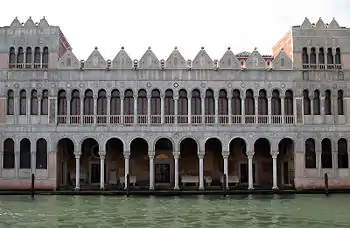
Thanks to the gigantic wealth of populari and grandi, only casual conflicts occurred. The two strata converged to only one, whose members were regarded as the Magni. They held the political power and monopolized the profits of long-distance trade. Pressure was further reduced by sending 3,000 to 4,000 men and their families to Crete. Some of the nobles conquered little empires of their own in the Aegean; many of them were sent as placeholders to hundreds of military and administrative posts.
The Venetian empire reached from Venice to Crete. Its centre point was the Golden Horn. Although Venice was completely unable to conquer the three eighths of the old empire that the crusaders had conceded to Enrico Dandolo, it secured strategic points.
Forms of company
The typical form of company was the so-called Collegantia. Within its frame a silent partner introduced about three quarters of the capital investment, the active partner, who conducted the trade, introduced the rest. Aims, responsibility assignment and shares were fixed before the journey being started, but the active partner could also reinvest his gains during the same journey. In a way silent and active partner were only roles that were fixed before each adventure, in which several silent partners could dare their luck. This way the risks diminished and the opportunities to accumulate capital increased. Close relationships and dependencies were developed and as a consequence family partnerships were largely preferred.
Not before the Late Middle Ages – and thus very late in comparison to Tuscany - veritable societates prevailed, companies conceived for longer periods. In addition double-entry bookkeeping enhanced the possibilities to stretch initiatives into rather far away countries by founding outposts or factories, and by enhancing controlling. Directing activities and intensification of local contacts were facilitated this way, too.
Venice as key of world trade between 13th and 15th century
The Arabian conquest of Jerusalem caused a long lasting deviation of trade routes to Baghdad and Tabriz. Cilician Armenia was now the main hub of trade. In addition the Venetians lost their main ports in Egypt and in 1291 also the most important Akkon.
They could only try to make their way through Armenia, Persia, Turkestan. After long and difficult negotiations they were re-admitted in Byzantium.
This was very important in so far as sailing through the Bosporus was now the most important way to reach Central Asia. It was not by coincidence that Marco Polo travelled through Asia in these years between 1278 and 1291. A second way led to Trabzon further to the Persian Gulf to India, a third one from Tana at the mouth of the river Don to the Volga and the Caspian Sea to India.
But the larger part of trade was conducted by sea-vessels and not overland. Venice so developed a system of regular convoys with strong protective means, but also encouraged private trading.
Decline
According to Diego Puga and Daniel Trefler, the Serrata del Maggior Consiglio (which parliamentary participation hereditary) lead to barriers to participation in the most profitable aspects of long-distance trade. This diminished the ability of members outside the hereditary aristroracy from participating in political decisions and in economic processes such as the colleganza. This stratification in political and enomic power led to a fundamental shift from political openness, economic competitivity, and social mobility and lead to political closure, extreme economic inequality, and social stratification and stiffness.[11]
According to economic historian Jan De Vries, Venice's economic power in the Mediterranean had declined significantly by the start of the 17th century. De Vries attributes this decline to the loss of the spice trade, a declining uncompetitive textile industry, competition in book publishing due to a rejuvenated Catholic Church, the adverse impact of the Thirty Years' War on Venice's key trade partners, and the increasing cost of cotton and silk imports to Venice.[12]
Immigration
The population of Venice – maybe 85,000 to 100,000 at about 1300 – could only bear these permanent losses, because there was also a permanent influx. This influx was heavily encouraged by Venetian officials, especially after the waves of Black Death after 1348. Specialists like silk weavers from Lucca or mill builders and bakers of the Holy Roman Empire migrated in droves. Consequently, Venice was forced to expand within its narrow territory, so gardens and swamps were largely replaced by dwellings.
Large numbers of people also immigrated from Tuscany, especially from Florence, as well as southern Italy, Greece, Croatia and even France. From about 1250 an increasing number of people came from the Holy Roman Empire – Germans, Hungarians or Bohemians – called "tedeschi“. They dwelled in the Fondaco dei Tedeschi and they were helped and controlled by Visdomini del Fondaco. Official brokers or middle-men were the only ones who were allowed to buy and sell the products.
Also immigrating to Venice, the Jewish people offered much more and cheaper credit to the Venetians, but most of them lived in Mestre. However, with the foundation of the Ghetto in 1516, the majority of the Jewish people started to live in secluded quarters, locked up at night.
Further reading
- John McManamon/Marco D'Agostino/Stefano Medas, Excavation and Recording of the Medieval Hulls at San Marco in Boccalama (Venice), in: The INA Quarterly. The Publication of the Institute of Nautical Archaeology 30 (2003) 22–28, als PDF (Nr.1, Jahrgang 30):[13]
- Ludwig Beutin, Der wirtschaftliche Niedergang Venedigs im 16. und 17. Jahrhundert, in: Hansische Geschichtsblätter 76 (1958) 42–72
- Ludo (Ludwig) Moritz Hartmann, Die wirtschaftlichen Anfänge Venedigs, in: Vierteljahrschrift für Wirtschafts- und Sozialgeschichte 2 (1904) 434–442[14]
- Heinrich Kretschmayr, Geschichte von Venedig, 3 Bde, Gotha 1905 und 1920, Stuttgart 1934, Nachdruck Aalen 1964
- Frederic C. Lane, Venice. A Maritime Republic, Baltimore, London 1973
- Gino Luzzatto, Storia economica di Venezia dall'XI al XVI secolo, Venedig 1961, Nachdruck 1995
- Storia di Venezia, 8 Voll, Rome 1992–2002
- Benjamin Arbel, Trading Nations: Jews and Venetians in the Early Modern Eastern Mediterranean, Leiden 1995
- Jean-Claude Hocquet, Denaro, navi e mercanti a Venezia 1200–1600, Rom 1999
- Ugo Tucci, The psychology of the Venetian merchant in the sixteenth century, in: Renaissance Venice, J. R. Hale (ed.), London 1973, 346–378
- Robert C. Davies, Shipbuilders of the Venetian Arsenal. Workers and workplace in the preindustrial city, Baltimore/London 1991
- Maurice Aymard, Venise, Raguse et le commerce du blé pendant la seconde moitie du XVIe siècle, Paris 1966
- Philippe Braunstein, De la montagne à Venise: les réseaux du bois au XVe siècle, in: MEFR 100 (1988) 761–799
- Salvatore Ciriacono, Les manufactures de luxe à Venise: contraintes géographiques, goût méditerranéen et compétition internationale (XIVe-XVIe siècles), in: Les villes et la transmission des valeurs culturelles au bas Moyen Age et aux temps modernes, Brüssel 1996, 235-251
- Salvatore Ciriacono, L’olio a Venezia in età moderna. I consumi alimentari e gli altri usi, in: Alimentazione e Nutrizione, secc. XIII – XVIII, Florenz 1997, 301 – 312[15]
- N. Fano, Ricerche sull'arte della lana a Venezia nel XIII e XIV secolo, in: Archivio Veneto Va serie 18 (1936) 73–213
- Jean-Claude Hocquet, Chioggia, Capitale del Sale nel Medioevo, Sottomarina 1991
- Hans-Jürgen Hübner, Quia bonum sit anticipare tempus. Die kommunale Versorgung Venedigs mit Brot und Getreide vom späten 12. bis ins 15. Jahrhundert, Peter Lang 1998 ISBN 3-631-32870-2
- Luca Molà (ed.), The Silk Industry of Renaissance Venice, Baltimore 2000
- Sergej P. Karpov, La navigazione veneziana nel Mar nero, XIII–XV sec., Ravenna 2000 ISBN 88-7567-359-4
- Ralph-Johannes Lilie, Handel und Politik zwischen dem Byzantinischen Reich und den italienischen Kommunen Venedig, Pisa und Genua in der Epoche der Komnenen und Angeloi (1081–1204), Amsterdam 1984
- Gerhard Rösch, Venedig und das Reich. Handels- und verkehrspolitische Beziehungen in der deutschen Kaiserzeit, Tübingen 1982
- Freddy Thiriet, La Romanie vénitienne au Moyen Age. Le développement et l'exploitation du domaine colonial vénitien (XII–XV siècles), Paris 1959, 2. Aufl. 1975
- Tommaso Bertelè, Bilanci generali della Repubblica di Venezia, Venedig 1912
- Roberto Cessi (ed.), La regolazione delle entrate e delle spese (sec. XIII–XIV), Padua 1925
- Frederic C. Lane/Reinhold C. Mueller, Money and Banking in Medieval and Renaissance Venice, Vol. 1: Coins and Moneys of Account, Vol. 2: The Venetian Money Market: Banks, Panics and the Public Debt, 1200–1500, Baltimore/London 1985 and 1997
- Gino Luzzatto, I prestiti della Repubblica di Venezia (sec. XIII–XV), Padua 1929
- Reinhold C. Mueller, L'imperialismo monetario veneziano nel Quattrocento, in: Società e Storia 8 (1980) 277–297
- Luciano Pezzolo, Il fisco dei veneziani. Finanza pubblica ed economia tra XV e XVII secolo, Verona 2003
- Alan M. Stahl, The Venetian Tornesello. A medieval colonial coinage, New York 1985
- Ugo Tucci, Monete e riforme monetarie nell'Italia del settecento, in: Rivista Storica Italiana 98 (1986) 78–119
- Franco Brunelli, Arti e mestieri a Venezia nel medioevo e nel rinascimento, Vicenza 1981
- Elizabeth Crouzet-Pavan, „Sopra le acque salse“. Escpaces, pouvoir et société à Venise à la fin du Moyen Age, 2 Bde, Rome 1992
- Gerhard Rösch, Der venezianische Adel bis zur Schliessung des Grossen Rates: zur Genese einer Führungsschicht, Sigmaringen: Thorbecke 1989
- Alvise da Mosto, L'ARCHIVIO DI STATO DI VENEZIA. INDICE GENERALE, STORICO, DESCRITTIVO ED ANALITICO (PDF, 796 kB oder im HTML-Format) – das Überblickswerk über die Bestände des Staatsarchivs von Venedig und damit über die wichtigsten Quellenbestände zum Thema.
- Franscisco Apellániz, Venetian Trading Networks in the Medieval Mediterranean, Journal of Interdisciplinary History 44.2 (2013): 157–179.
- Roberto Cessi (ed.), Documenti relativi alla storia di Venezia anteriori al Mille, in: Testi e Documenti di storia e di letteratura Latina medioevale, Bd. 1–3, Padua 1942–43
- Roberto Cessi (ed.), Liber Plegiorum & Acta Consilii Sapientum (Deliberazioni del Maggior Consiglio di Venezia, Bd. 1), Bologna 1950
- Georg Martin Thomas, Diplomatarium Veneto-Levantinum sive Acta et Diplomata Res Venetas Graecas atque Levantis illustrantia, 2 Bde, Venedig 1880/99, ND New York 1966 (enthält zahlreiche Vertragstexte zwischen Byzanz und Venedig)
References
- Cfr. the works of J. Cl. Hocquet.
- Hübner, Quia bonum sit anticipare tempus, 132
- Cassiodor, Variae, X, 27 und XII, 24.
- Beyerle, Leges Langobardorum, 195 (Ahistulfi leges I,4).
- Honorantiae Civitatis Papiae
- Codex Carolinus 86, Monumenta Germaniae Historica, Epistolae III, S. 622
- Liber pontificalis 222, ed. Duchesne.
- a figure
- Dölger, Regesten n. 738
- Dölger, Regesten n. 400
- Puga, Diego; Trefler, Daniel (2014-05-01). "International Trade and Institutional Change: Medieval Venice's Response to Globalization". The Quarterly Journal of Economics. 129 (2): 753–821. doi:10.1093/qje/qju006. ISSN 0033-5533.
- "Jan de Vries. <italic>Economy of Europe in an Age of Crisis, 1600–1750</italic>. New York: Cambridge University Press. 1976. Pp. xi, 284. Cloth $14.95, paper $4.95". The American Historical Review. June 1977. doi:10.1086/ahr/82.3.623-a. ISSN 1937-5239.
- ina.tamu.edu Archived 2011-09-29 at the Wayback Machine 3,5 MB
- www.digizeitschriften.de
- "venus.unive.it Ciriacono3.pdf" (PDF). Archived from the original (PDF) on 2010-01-19. Retrieved 2011-08-12.
External links
- Hans-Jürgen Hübner: Wirtschaftsgeschichte Venedigs (German)
- Coins (engl.)
- Venezia e le isole della Laguna archeologia subacquea (ital.)
